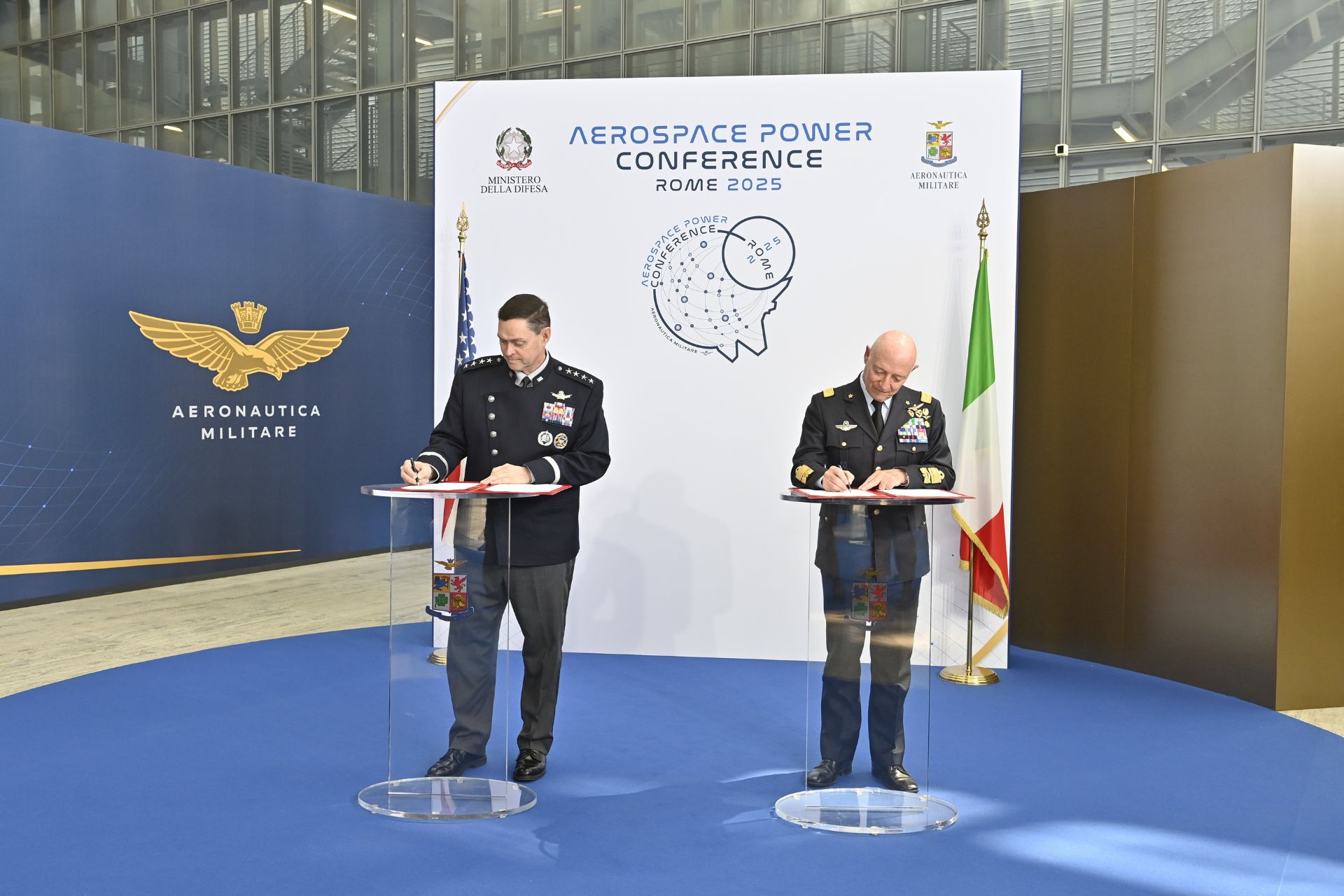US Space Force Partners with Italian Air Force to Counter Growing Threats in Space

{loadposition bannertop}
{loadposition sidebarpub}
On May 8, 2025, on the sidelines of the Aerospace Power Conference held in Rome, General Chance Saltzman, Chief of Space Operations of the U.S. Space Force (USSF), and General Luca Goretti, Chief of Staff of the Italian Air Force, signed a statement of understanding aimed at strengthening their cooperation in space security. This document represents a tangible deepening of the transatlantic partnership at a time when space is increasingly recognized as a fully operational domain, essential to deterrence, command, and force projection capabilities.
Follow Army Recognition on Google News at this link
The agreement between the United States and Italy comes at a time when the militarization of space is no longer a distant prospect but an established operational reality (Picture source: US Space Forces )
The agreement reflects a shared commitment to improving interoperability between the two forces, in a context shaped by rapid technological developments, the proliferation of space actors, and the rise of increasingly sophisticated orbital threats. General Saltzman emphasized that the statement constitutes a concrete step forward in joint efforts to secure the space domain, underlining the need to align missions, doctrines, and resources. General Goretti highlighted the opportunity this cooperation offers to enhance national expertise while contributing to collective security in space, now considered a strategic theatre of operations alongside the land, sea, air, and cyber domains.
The statement builds upon an already established framework of military cooperation through the Military Personnel Exchange Program, which enables reciprocal exchanges of qualified personnel between the two nations. This new step paves the way for the deployment of a USSF expert team to Italy and, in turn, for the integration of Italian Air Force officers into the U.S. Space Force. The initiative is designed to enhance mutual understanding of operational concepts, harmonize planning procedures, and jointly anticipate technological shifts in an increasingly complex, saturated, and strategically significant space environment.
This bilateral initiative takes place in an international context marked by intensifying competition for access to and control of outer space, illustrated by the development of anti-satellite capabilities, the proliferation of dual-use commercial constellations, and growing ambiguity in orbital behaviors. The protection of military and civilian satellites—now critical for communications, navigation, intelligence, and joint operations—has become a central sovereignty issue. In this context, both the United States and Italy view enhanced cooperation not only as an operational necessity but also as a political and strategic tool to preserve free, secure, and sustainable access to space.
The agreement between the United States and Italy comes at a time when the militarization of space is no longer a distant prospect but an established operational reality. For several years, powers such as China and Russia have actively developed anti-satellite systems, electromagnetic jamming capabilities, and space vehicles capable of close-proximity maneuvers that can interfere with the satellites of other nations. These developments have turned space into a domain that is not only vulnerable but also contested, competitive, and potentially conflictual, according to terminology now embedded in Western military doctrines. In this context, the protection of orbital infrastructure, such as GPS navigation systems, ISR satellites, command networks, and encrypted communications, has become a critical strategic priority. Space is now understood as a force multiplier, whose partial or total degradation could significantly impair the conduct of modern military operations.
In terms of capabilities, the United States currently possesses the most extensive military space infrastructure in the world, structured around the U.S. Space Force and the United States Space Command. This includes Space-Based Infrared System (SBIRS) satellites for missile warning, Wideband Global SATCOM (WGS) and Advanced Extremely High Frequency (AEHF) constellations for strategic communications, next-generation GPS navigation systems, and space traffic surveillance networks such as SPACETRACK and Space Fence. Italy, while operating on a more limited scale, has developed recognized expertise, particularly through its dual-use Cosmo-SkyMed radar observation satellites, produced by Leonardo and Thales Alenia Space. These systems provide high-resolution imaging used by the Italian armed forces as well as civilian and international partners. Italy also contributes to the European MUSIS program (Multinational Space-based Imaging System), which aims to pool space imaging capabilities among several EU member states. The strengthening of bilateral cooperation thus enables the sharing of data, improves the resilience of orbital architectures, and facilitates cost-sharing for the development, launch, and maintenance of sovereign systems in a domain that remains highly demanding in both technological and industrial terms.
Ultimately, the agreement signed on May 8, 2025, between the U.S. Space Force and the Italian Air Force reflects growing strategic convergence between Washington and Rome in response to new space-related challenges. By improving interoperability, fostering knowledge exchange, and deepening institutional cooperation, the two countries demonstrate their intent to build a robust, resilient, and integrated space security architecture. This expanded partnership should support more coordinated responses to emerging threats while reinforcing a collective posture of space defense. It may also serve as a foundation for future alignment between transatlantic efforts and broader European ambitions in the realm of space sovereignty.

{loadposition bannertop}
{loadposition sidebarpub}
On May 8, 2025, on the sidelines of the Aerospace Power Conference held in Rome, General Chance Saltzman, Chief of Space Operations of the U.S. Space Force (USSF), and General Luca Goretti, Chief of Staff of the Italian Air Force, signed a statement of understanding aimed at strengthening their cooperation in space security. This document represents a tangible deepening of the transatlantic partnership at a time when space is increasingly recognized as a fully operational domain, essential to deterrence, command, and force projection capabilities.
The agreement between the United States and Italy comes at a time when the militarization of space is no longer a distant prospect but an established operational reality (Picture source: US Space Forces )
The agreement reflects a shared commitment to improving interoperability between the two forces, in a context shaped by rapid technological developments, the proliferation of space actors, and the rise of increasingly sophisticated orbital threats. General Saltzman emphasized that the statement constitutes a concrete step forward in joint efforts to secure the space domain, underlining the need to align missions, doctrines, and resources. General Goretti highlighted the opportunity this cooperation offers to enhance national expertise while contributing to collective security in space, now considered a strategic theatre of operations alongside the land, sea, air, and cyber domains.
The statement builds upon an already established framework of military cooperation through the Military Personnel Exchange Program, which enables reciprocal exchanges of qualified personnel between the two nations. This new step paves the way for the deployment of a USSF expert team to Italy and, in turn, for the integration of Italian Air Force officers into the U.S. Space Force. The initiative is designed to enhance mutual understanding of operational concepts, harmonize planning procedures, and jointly anticipate technological shifts in an increasingly complex, saturated, and strategically significant space environment.
This bilateral initiative takes place in an international context marked by intensifying competition for access to and control of outer space, illustrated by the development of anti-satellite capabilities, the proliferation of dual-use commercial constellations, and growing ambiguity in orbital behaviors. The protection of military and civilian satellites—now critical for communications, navigation, intelligence, and joint operations—has become a central sovereignty issue. In this context, both the United States and Italy view enhanced cooperation not only as an operational necessity but also as a political and strategic tool to preserve free, secure, and sustainable access to space.
The agreement between the United States and Italy comes at a time when the militarization of space is no longer a distant prospect but an established operational reality. For several years, powers such as China and Russia have actively developed anti-satellite systems, electromagnetic jamming capabilities, and space vehicles capable of close-proximity maneuvers that can interfere with the satellites of other nations. These developments have turned space into a domain that is not only vulnerable but also contested, competitive, and potentially conflictual, according to terminology now embedded in Western military doctrines. In this context, the protection of orbital infrastructure, such as GPS navigation systems, ISR satellites, command networks, and encrypted communications, has become a critical strategic priority. Space is now understood as a force multiplier, whose partial or total degradation could significantly impair the conduct of modern military operations.
In terms of capabilities, the United States currently possesses the most extensive military space infrastructure in the world, structured around the U.S. Space Force and the United States Space Command. This includes Space-Based Infrared System (SBIRS) satellites for missile warning, Wideband Global SATCOM (WGS) and Advanced Extremely High Frequency (AEHF) constellations for strategic communications, next-generation GPS navigation systems, and space traffic surveillance networks such as SPACETRACK and Space Fence. Italy, while operating on a more limited scale, has developed recognized expertise, particularly through its dual-use Cosmo-SkyMed radar observation satellites, produced by Leonardo and Thales Alenia Space. These systems provide high-resolution imaging used by the Italian armed forces as well as civilian and international partners. Italy also contributes to the European MUSIS program (Multinational Space-based Imaging System), which aims to pool space imaging capabilities among several EU member states. The strengthening of bilateral cooperation thus enables the sharing of data, improves the resilience of orbital architectures, and facilitates cost-sharing for the development, launch, and maintenance of sovereign systems in a domain that remains highly demanding in both technological and industrial terms.
Ultimately, the agreement signed on May 8, 2025, between the U.S. Space Force and the Italian Air Force reflects growing strategic convergence between Washington and Rome in response to new space-related challenges. By improving interoperability, fostering knowledge exchange, and deepening institutional cooperation, the two countries demonstrate their intent to build a robust, resilient, and integrated space security architecture. This expanded partnership should support more coordinated responses to emerging threats while reinforcing a collective posture of space defense. It may also serve as a foundation for future alignment between transatlantic efforts and broader European ambitions in the realm of space sovereignty.





